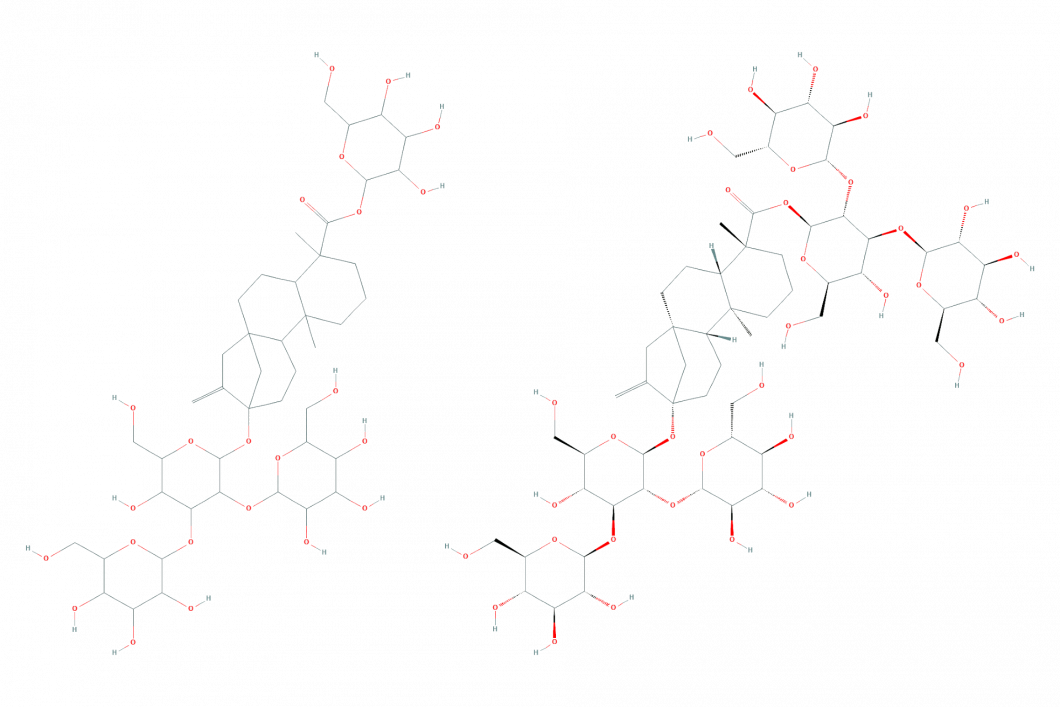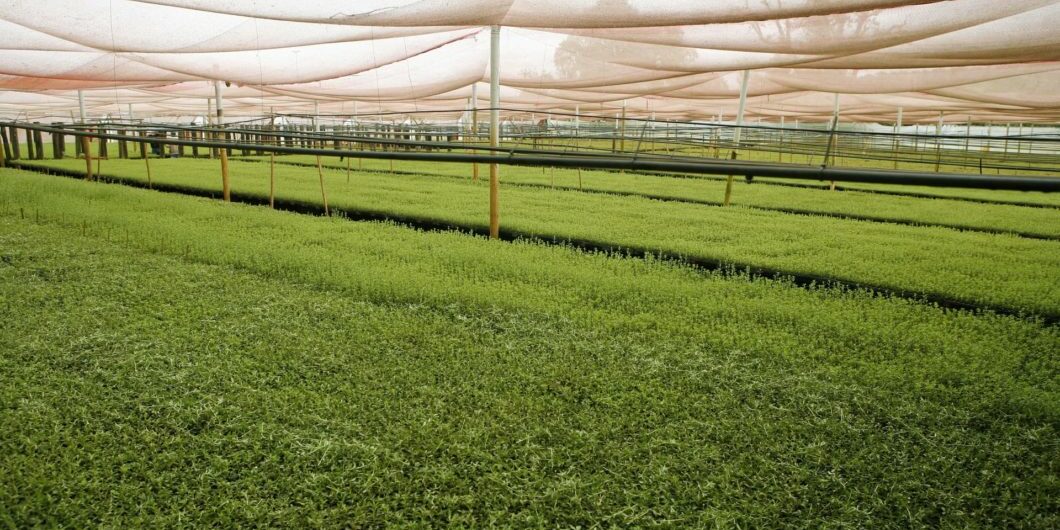Steviol glycosides are sweet substances found in the Stevia rebaudiana plant (usually called stevia). Twelve steviol glycosides are approved as sweeteners in the EU. They are not energizing (0 kcal), do not raise blood sugar (GI 0) and are also of natural origin. This makes them an excellent choice for reducing sugar in foods and beverages. Here you can learn more about stevia and steviol glycosides. You also get tips on more reading.
Steviol glycosides are the sweet substances extracted from the plant stevia, used as a calorie-free sweetener. In this article, we answer common questions about stevia and steviol glycosides.
What is stevia?
Stevia is a genus of 240 different species of plants in the subtropical and tropical parts of South America and western North America. But in practice, there is only one specie referred to – Stevia rebaudiana – which in English is called candyleaf, sweetleaf, or sugarleaf.
As the name implies, the leaves of the plant have a sweet taste. The sweetness comes from steviol glycosides found in the leaves of stevia. Steviol glycosides are 50–450 times sweeter than regular sugar.
Stevia has been used as a sweetener by the indigenous people of Paraguay and central South America for hundreds of years. Nowadays, stevia is grown for commercial extraction of steviol glycosides. Cultivations exist in central South America, China and Southeast Asia, and the USA. Farming is also done in some places in Europe.
What are steviol glycosides?
Steviol glycosides are the collective name of the sweet substances found naturally in the plant Stevia rebaudiana – which commonly is called stevia.
There are about forty different steviol glycosides. Twelve of them are approved as sweeteners in the EU. Of these twelve, three are mainly encountered in practice:
- Stevioside is the steviol glycoside most commonly found in stevia leaves (5–10%). It has a bitter taste and an aftertaste reminiscent of liquorice. Therefore, it is not used as much as when stevia was approved in 2011. Instead, the focus has been shifted to two more tasty steviol glycosides.
- Rebaudiana A (which is often abbreviated as Reb A) is found in a smaller proportion of stevia leaves (2–4%), but is the most commonly used steviol glycoside in food and beverages. Compared with stevioside, it has much less bitter off-taste and much less of an aftertaste of liquorice.
- Rebaudiana M (often abbreviated as Reb M) has no bitterness at all and no liquorice-like aftertaste. Its taste profile is almost identical to sugar. It makes it ideal for replacing the sweetness of the sugar. But the proportion of Reb M in stevia leaves is tiny (< 0.1%), which makes Reb M more expensive than Reb A.
All steviol glycosides consist of the substance steviol to which glucose molecules are linked with so-called glycosidic bonds.
The only thing that separates different steviol glycosides is how many glucose molecules are linked and where they are located. For example, stevioside is linked by three glucose moieties, and Reb A by four.
Reb M has a total of six glucose moieties. The high number of glucose moieties is part of the explanation for Reb M’s good taste; studies indicate that more glucose units produce more sweetness and less bitterness.

What makes steviol glycosides good as sweeteners?
There are two reasons why steviol glycosides are excellent sweeteners.
First and foremost, they supply no energy (0 kcal) and do not raise blood sugar (GI 0).
Also, steviol glycosides are found in nature, and they are extracted from stevia in much the same way that sugar is extracted from sugar beets and canes. Consequently, many consumers see them as a more natural alternative than synthetically produced sweeteners such as aspartame, acesulfame K and sucralose.
How are steviol glycosides extracted?
Steviol glycosides are extracted from the plant stevia in a way that is similar to how sugar is extracted from sugar beets and canes.
The plant is dried, and the leaves are separated from the stems. These are then soaked in hot water. The infusion contains steviol glycosides, but also plant pigment, gelatinous substances, oil, wax, proteins as well as tannic acid and other polyphenols which are separated through different filters.
The purified infusion is poured through ion exchange resin which captures steviol glycosides but lets the water through. Ion exchange resin is a porous material with an electrically charged surface that captures steviol glycosides. It’s the same technology used in water treatment plants. To remove the steviol glycosides from the porous material, it is rinsed with pure alcohol.
The alcohol is removed in a membrane filter and through distillation. What remains is a sweet syrup from which most of the remaining fluid is squeezed out before the leftovers are dried to become steviol glycoside crystals.
The crystals are then dissolved in alcohol again, and the process is repeated until you get the desired purity before they are dried and packaged.
Are steviol glycosides natural?
Steviol glycosides are naturally found in stevia plants, and they are extracted in a way that is similar to how sugar is extracted from sugar beets and canes. Nevertheless, steviol glycosides must not be called naturally according to EU legislation. However, it is ok to say that steviol glycosides are of natural origin.
Are steviol glycosides ecological?
Steviol glycosides extracted from organically grown stevia must not be called organic according to EU legislation. This is because an ion exchange resin is used in the extraction process.
Is it challenging to replace sugar with steviol glycosides?
There are of course challenges in replacing bulk sweeteners such as sugar with steviol glycosides. Only 3 grams of Reb A or Reb M are needed to replace 1 kilogram of sugar. What should the other 997 grams be replaced with to maintain the same texture and mouthfeel? And how should the off-taste and aftertaste of the cheaper Reb A be handled?
The solution is sweetened fibres. It is sugar-like particles consisting of dietary fibre wrapped in steviol glycosides and other ingredients necessary to obtain its desired properties. Sweetened fibres replace sugar one-by-one with unchanged taste and texture. One kilogram of sugar is replaced by one kilogram of sweetened fibres. It can also be transported, stored and used as regular sugar without any changes in routines or processes.
We have developed sweetened fibres for many typical applications (for example, bakery, chocolate, confectionery, dairy, soups and sauces). We market them under the trademark EUREBA®. They are ready to use as sugar replacement with little or no fine-tuning. That saves valuable time and shortens the time to market for sugar-reduced products.
We can also help you to customize your own sweetened fibres. We then use our own assortment of Reb A and Reb M, which we market under the trademark NAVIA®.
Read more
Read more about stevia and steviol glycosides in our online magazine. Start with these articles:
- Stevia – from seed to Eureba
- Stevia – the sweet plant that challenged the giant companies
- Why you should sweeten with Reb M
- How we safeguard quality — from cultivation to production

